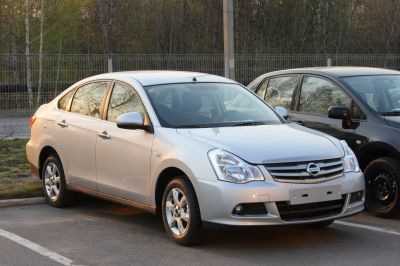 1998 Toyota Vista (V50) Dimensions, Size & Specs
1998 Toyota Vista (V50) Dimensions, Size & Specs
Measurements of the 1998 Toyota Vista, engineered for optimal performance and comfort
| Dimensions | |
|---|---|
| Length: | 4670 mm183.9 in15.3 ft |
| Width: | 1695 mm66.7 in5.6 ft |
| Height: | 1510 mm59.4 in5.0 ft |
| Weight Specifications | |
| Curb Weight: | 1210-1390 kg2668-3064 lbs |
| Tire Specifications | |
| Tire Size: |
|
The Toyota Vista V50 generation, produced from 1998 to 2003, is a mid-size sedan known for its balanced dimensions and practical design. With an overall length of 4670 mm (183.9 inches), the V50 offers ample cabin space without compromising urban maneuverability. The width of 1695 mm (66.7 inches) ensures comfortable shoulder room inside the cabin while maintaining a sleek exterior profile. Standing at a height of 1510 mm (59.4 inches), the Vista V50 maintains a low, aerodynamic stance that aids in both fuel efficiency and aesthetic appeal.
Weighing between 1210 to 1390 kilograms (2665 to 3064 pounds), this generation of the Vista offers a sturdy yet lightweight build that strikes a good balance between performance and fuel economy. The curb weight variation depends on specific trim levels and equipment packages. The car rides on 185/70 R14 tires, providing a stable driving experience suited for everyday road conditions, with an emphasis on comfort and grip.
Designed primarily as a sedan, the Vista V50 is intended for drivers seeking a reliable vehicle that fits well in both city and highway environments. Its dimensions make it easy to park in tighter spaces, yet sufficiently roomy for passengers and luggage, appealing to families and professionals alike.
Overall, the 1998-2003 Toyota Vista V50 combines classic styling with practical dimensions and reliable build quality, making it a noteworthy option in the mid-size sedan segment of its era.
Discover the standout features that make the 1998 Toyota Vista a leader in its class
Have a question? Please check our knowledgebase first.
The 1998 Toyota Vista (V50) measures 4670 mm (183.9 inches) in length, 1695 mm (66.7 inches) in width, and 1510 mm (59.4 inches) in height. These dimensions place it comfortably within the mid-size sedan category, providing a good balance of interior space and exterior manageability. The length of 4.67 meters ensures ample cabin space for passengers, while the width of 1.7 meters supports a roomy seating arrangement without making the vehicle too wide for narrow streets or parking spaces. The height of about 1.51 meters helps maintain a low and aerodynamic profile, contributing to better handling and fuel efficiency.
The curb weight of the Toyota Vista (V50) ranges between 1210 kg and 1390 kg (approximately 2667 to 3064 lbs), depending on the trim and equipment level. This moderate weight for a mid-size sedan contributes to a balanced driving experience with good fuel efficiency and manageable handling. A lighter curb weight usually results in better acceleration and braking performance, while also improving fuel consumption. As a result, the Vista (V50) achieves a reasonable compromise between structural solidity and efficiency, making it a practical choice for everyday driving.
The Toyota Vista (V50) comes equipped with 185/70 R14 tires. This tire size denotes a tire width of 185 mm, a sidewall height that is 70% of the width, and a 14-inch diameter wheel. These tires contribute to a well-rounded ride quality, offering a balance between comfort and handling. The relatively higher sidewalls (70 aspect ratio) help absorb road imperfections, which enhances ride comfort on various surfaces. Meanwhile, the 14-inch wheel size supports reliable performance in terms of maneuverability and braking.
Yes, the Toyota Vista (V50), with its length of 4670 mm (183.9 inches), width of 1695 mm (66.7 inches), and height of 1510 mm (59.4 inches), easily fits into most standard residential garages worldwide. Typical garages have an internal width of about 2.4 to 2.7 meters (94 to 106 inches) and a depth of around 5 to 6 meters (197 to 236 inches), which comfortably accommodates the V50. Its relatively modest width and height ensure that entering and maneuvering within the garage is hassle-free, making it practical for everyday use in typical urban or suburban settings.
Compared to its predecessor, the Toyota Vista (V40 generation), the V50 (1998-2003) exhibits a slight increase in dimensions, mainly in length and width. The visual appearance is more modern and aerodynamic while maintaining similar height for interior comfort. This size increase translates to improved interior room, especially rear passenger legroom and trunk capacity, enhancing overall passenger comfort and practicality. Additionally, the V50 refined its suspension and chassis to better leverage the slightly larger size, resulting in improved ride quality and handling compared to the earlier generation.
The Toyota Vista (V50) fits well within the mid-size sedan segment of the late 1990s and early 2000s. For comparison, it is similar in length to the Honda Accord of the same period, which measures around 4650 to 4700 mm in length, and width is also comparable. However, some competitors might be slightly wider or have a higher curb weight. The Vista’s slightly narrower width of 1695 mm (66.7 inches) means it can be easier to maneuver in tight urban environments compared to wider sedans. Overall, the Vista offers competitive dimensions balancing interior space with urban practicality.
While specific interior dimensions for the Toyota Vista (V50) are less commonly published, its exterior size—length of 4670 mm, width of 1695 mm, and height of 1510 mm—suggests a comfortable cabin for a mid-size sedan. The vehicle’s design maximizes interior volume with sufficient headroom and legroom for front and rear passengers, making it suitable for family use or longer trips. The relatively elongated body allows for spacious seats and a roomy rear compartment, while the moderate width ensures passenger comfort without excessive bulk. This makes the Vista practical for both city driving and highway cruising.
As a mid-size sedan, the Toyota Vista (V50) offers a reasonably sized trunk suitable for everyday needs such as grocery shopping, luggage for travel, or storing work materials. Thanks to its 4670 mm length, the car accommodates a practical trunk volume, typically competitive with other mid-size sedans of its era. While the exact trunk volume is not specified here, one can expect a space generally ranging between 400 to 450 liters (14 to 16 cubic feet), providing adequate cargo capacity for typical passenger car usage. Folding rear seats, if available, further enhance cargo flexibility.
Given its dimensions, especially a width of 1695 mm (66.7 inches) and overall length of 4670 mm (183.9 inches), the Toyota Vista (V50) delivers decent maneuverability for a mid-size sedan. Its moderate width helps when navigating narrow streets or tight parking spaces, while the length, though on the longer side for compact urban environments, is manageable with adequate turning radius and driver visibility. Combined with typical 14-inch tires, it remains composed and easy to handle in standard city and suburban driving conditions, making parking and daily use relatively effortless.
The Toyota Vista (V50) generation, produced from 1998 to 2003, is a mid-size sedan known for its reliability, comfortable ride, and balanced design. It often featured efficient four-cylinder engines paired with manual or automatic transmissions, aimed at providing a smooth everyday driving experience. The V50 generation represented modernized styling compared to its predecessors, emphasizing aerodynamic lines and a more refined interior. Safety and comfort were focal points, with options like airbags, improved suspension, and better sound insulation. It targeted families and professionals seeking a practical yet well-rounded vehicle.
Discover similar sized cars.

| Production: | 1954-1956 |
|---|---|
| Model Year: | 1954 |
| Length: | 4715 mm185.6 in |
| Width: | 1740 mm68.5 in |
| Height: | 1560 mm61.4 in |

| Production: | 1956-1959 |
|---|---|
| Model Year: | 1956 |
| Length: | 4715-4750 mm185.6-187.0 in |
| Width: | 1740 mm68.5 in |
| Height: | 1560 mm61.4 in |

| Production: | 2012-2018 |
|---|---|
| Model Year: | 2013 |
| Length: | 4656 mm183.3 in |
| Width: | 1695 mm66.7 in |
| Height: | 1522 mm59.9 in |

| Production: | 2019-2022 |
|---|---|
| Model Year: | 2019 |
| Length: | 4700 mm185.0 in |
| Width: | 1725 mm67.9 in |
| Height: | 1530 mm60.2 in |

| Production: | 2022-present |
|---|---|
| Model Year: | 2022 |
| Length: | 4700 mm185.0 in |
| Width: | 1725 mm67.9 in |
| Height: | 1530 mm60.2 in |
